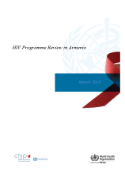HIV Programme Review in Armenia (2015)

Download
This WHO country mission conducted in January 2015 aimed to review five key components of the HIV/AIDS programme in Armenia:
- epidemiology;
- the HIV surveillance system;
- HIV treatment and care along the cascade of services;
- HIV services for key populations; and
- service delivery models for populations affected by the HIV epidemic from the perspective of the health system.
Armenia has a low HIV prevalence overall with a concentrated epidemic specifically affecting people who inject drugs, migrant workers, men who have sex with men, and sex workers. According to 2014 data, an estimated 4,000 people are living with HIV in the country of whom fewer than two out of five are aware of their status and only one-third are linked to care.
HIV and AIDS services are centralized at the National Centre for AIDS Prevention in the capital of the country and a key overarching recommendation for the country is to carefully fully or partially decentralize aspects of HIV prevention, treatment and care to reach those most in need including targeted testing to reach those unaware of their status. As a part of this process, additional training for health care providers as well as non-governmental organizations is needed and both stigma and discrimination will need to be addressed among health care providers and the general populations.
Additional recommendations are made in this report for the rationalization of antiretroviral therapy regimens; expanded testing; the increased provision of opioid substitution therapy, and government supported needle and syringe programmes for people who inject drugs.



